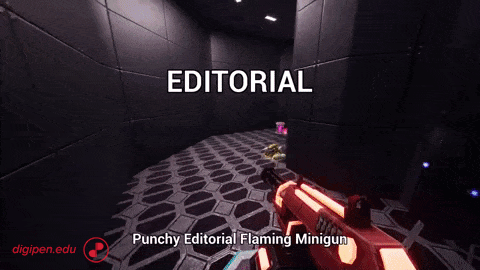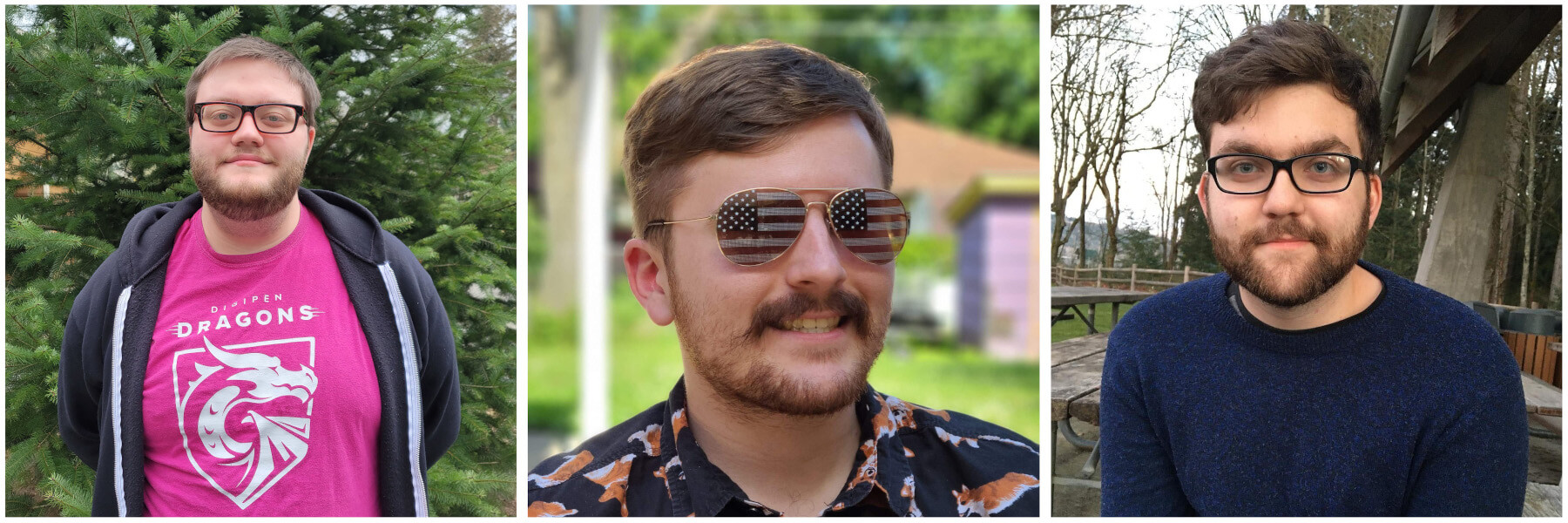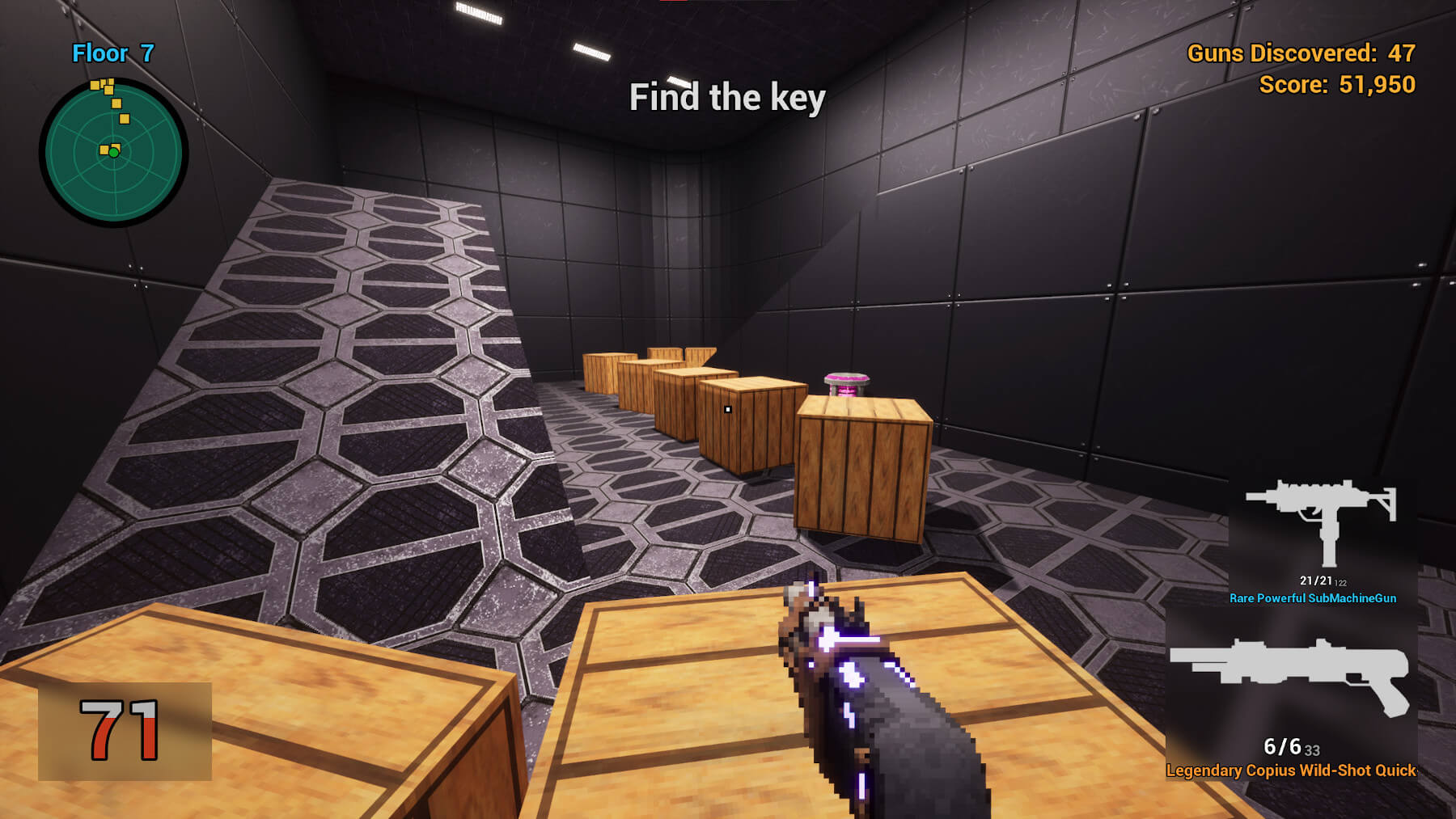Benjamin Fox, Jared Joyal, and Michael Crouch had a feeling their DigiPen senior game project would likely get some attention when they launched on Steam last March. For starters, it had an intriguing concept built right into the title — OMFG: One Million Fatal Guns.
“I thought our game was pretty fun. So, you know, I expected a couple reviews, maybe some let’s plays,” Crouch (BS in Computer Science and Game Design), the game’s AI programmer, says.
What they didn’t expect was to have their game appear on the front page of the entire digital storefront, immediately viewable to millions of players around the world.
“We got it ready to go up on Steam, and then when it came out we were like, ‘Hey, this is pretty cool.’ We shared it with some of our friends,” Crouch says. “Then maybe a day or two later, someone replied back with, ‘Hey, your game’s on New and Trending.’”
Just like it sounds, the Steam ‘New and Trending’ section is like a real-time leaderboard of the top 10 best performing new releases — a list that often includes both popular indie and AAA games alike. By April 1, OMFG had been advertised more than 28 million times, leading to more than 82,500 downloads with an average 2,661 people playing the game each day since its release.
“Just the scale of it — it’s still super impressive to me,” Joyal (BS in Computer Science in Real-Time Interactive Simulation), the game’s UI programmer, says.
 The premise of OMFG is simple. It’s a first-person shooter where the goal is to survive for as long as possible as you blast your way through room after room filled with deadly, swarming robots. All the while, players have access to a dizzying array of quirky and unique firearms that drop as loot from crates and enemies.
The premise of OMFG is simple. It’s a first-person shooter where the goal is to survive for as long as possible as you blast your way through room after room filled with deadly, swarming robots. All the while, players have access to a dizzying array of quirky and unique firearms that drop as loot from crates and enemies.
According to the developers, the guns come in about 30 million potential varieties thanks to their randomized, mix-and-match properties and characteristics. From plasma guns that shoot green globs of powerful energy to “Editorial” weapons that fire off literal strings of text, discovering the extensive variety of weapon types is a big part of the game’s appeal. Whereas players might start out with something as unimpressive sounding as a “Standard Issue Peashooter,” it won’t be long before they’re finding guns with hilariously verbose names, such as “Legendary Copious Powerful Golden Spelunking Pump Shotgun.”
“And now there’s a Steam community guide outlining what all of the different prefixes are and what they do,” Fox (BS in Computer Science in Real-Time Interactive Simulation), the game’s systems programmer, says.
For all three students, the success of their senior project is particularly special for multiple reasons. For one, the trio has been collaborating since their first year at DigiPen, OMFG being their fourth game project to be released on Steam. It’s also a direct sequel to their freshman-level GAM 150 project, OMG: One Million Guns.

Like OMFG, the original game was built around the concept of blasting away waves of robot enemies with a procedurally generated arsenal of firearms. Unlike its sequel, a 3D game built in Epic’s Unreal Engine, the original OMG: One Million Guns is a top-down, twin-stick shooter that takes place in a single arena.
For a first-year game project, OMG was a pretty big success in its own right, earning a spot in DigiPen’s 2018 PAX Arcade booth and an invitation in 2019 to be showcased at the DreamHack Atlanta gaming expo. The game marked an auspicious beginning for the team, and the three students credit GAM class instructor Justin Chambers for helping them refine the core concept after initially struggling with how to design a top-down shooter.
“We were talking about, ‘What if we had shops or a currency for upgrading? What if we had a dune buggy that drives across the screen?’” Joyal says. “And the professor for that class was very kind to say, ‘You’re over-scoping. It’s what you do. Let’s just pick one thing.’”
“Justin told us, ‘What if, instead of a shop where you buy different kinds of guns, you just make the whole game all about having as many different kinds of guns as possible?’” Fox recalls. “And we were like, ‘Yeah, that sounds really cool! Let’s do that.’ And he said, ‘Yeah, you could name it something funny, like One Million Guns.’ We were like, ‘Yes, that’s it.’”
I think GAM is a really fantastic opportunity to gather up all the ideas that you’ve been taught in all your classes and see how they fit together in kind of a sandbox environment.
The three computer science students had such a positive experience working together that they decided to reunite for their sophomore year and invite even more friends and classmates onto a larger team that would go by the name Nuclear Lunch. That team went on to create the rock-and-roll-themed beat-em-up Mosh Pit, which was developed in a custom 2D game engine with an art team led by fellow student AD Taeza from the BFA in Digital Art and Animation program.
“That was a really interesting space to work in, just because of the vast influence of the artists. The game was really driven by AD and the rest of our art team, where the programmers were more of the backbone,” Joyal says.
The Nuclear Lunch team largely stayed together for the junior game project, Homeland: Lay to Rest. The 3D action adventure marked the first time the students would work together using a commercial engine, and the results generated a fair bit of attention. It was midway through that project when, on the trip to DreamHack Atlanta to show off OMG, the idea for a sequel started to take shape.
“That kind of revitalized our excitement for that project,” Fox says. “And we all started talking, like, ‘Hey, what if we did this but in 3D for GAM 400 next year?’ And we were like, ‘OK. Well, what would we call it?’ We were like, ‘What about OMFG?’”

After landing internships during the summer of last year — Fox and Joyal at Epic Games and Crouch at Raven Software — the three teammates joined together last fall to collaborate on one final game project, alongside two other former teammates from Nuclear Lunch, graphics and tools programmer Matt Haynie (BS in Computer Science in Real-Time Interactive Simulation) and volunteer artist Caleb Hesse (BFA in Digital Art and Animation). This time, they went by the team name Gun Hit Wonders, a name that turned out to be rather fitting.
While the peak of OMFG’s spectacular debut may have come and gone, the three student programmers are already on to bigger and better things. Having graduated in December, both Crouch and Joyal have hit the ground running in their professional careers.
“I work at ZeniMax Online Studios on Elder Scrolls Online as a gameplay engineer. It’s been pretty great so far,” Crouch says. “I feel that DigiPen has really prepared me for it.”
Joyal, in turn, returned to Epic Games and is working on Fortnite as a UI programmer.
“It is really fun working on Fortnite as a live game, because there’s always this mentality where you have millions of players who will see every change you do, and likewise millions of players who will report every bug you make,” Joyal says. “So that’s very exciting.”
Fox, meanwhile, currently plans to graduate at the end of the summer, at which point he too will be returning to Epic Games. Looking back, all three students say they are thankful for the learning opportunities their four years of game project classes provided.
“I think GAM is a really fantastic opportunity to gather up all the ideas that you’ve been taught in all your classes and see how they fit together in kind of a sandbox environment,” Joyal says. “You have a goal: Make a game. Make a game in a 2D custom engine. Make a 3D game in a commercial engine. You have to find what building blocks you’ve picked up along the way work to help you achieve that goal in as efficient a way as possible. And that’s something that one-to-one directly translates to my professional work.”
Crouch echoes his sentiments.
“I think GAM is the most valuable part of DigiPen, period,” Crouch says. “It’s where the practicality meets theory, where you actually don’t have anyone telling you what to do. You just have to figure out how to do it.”
